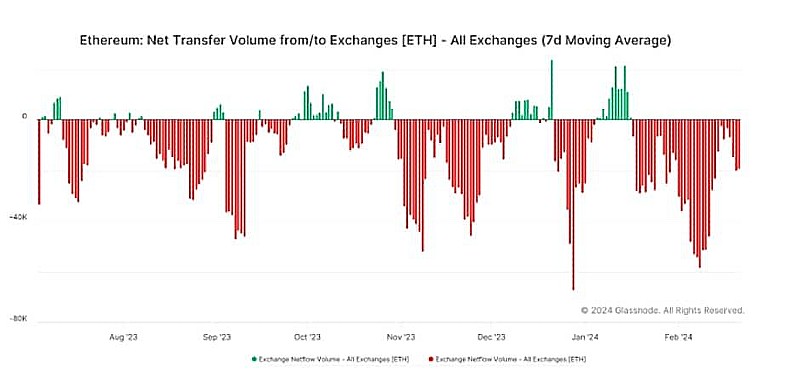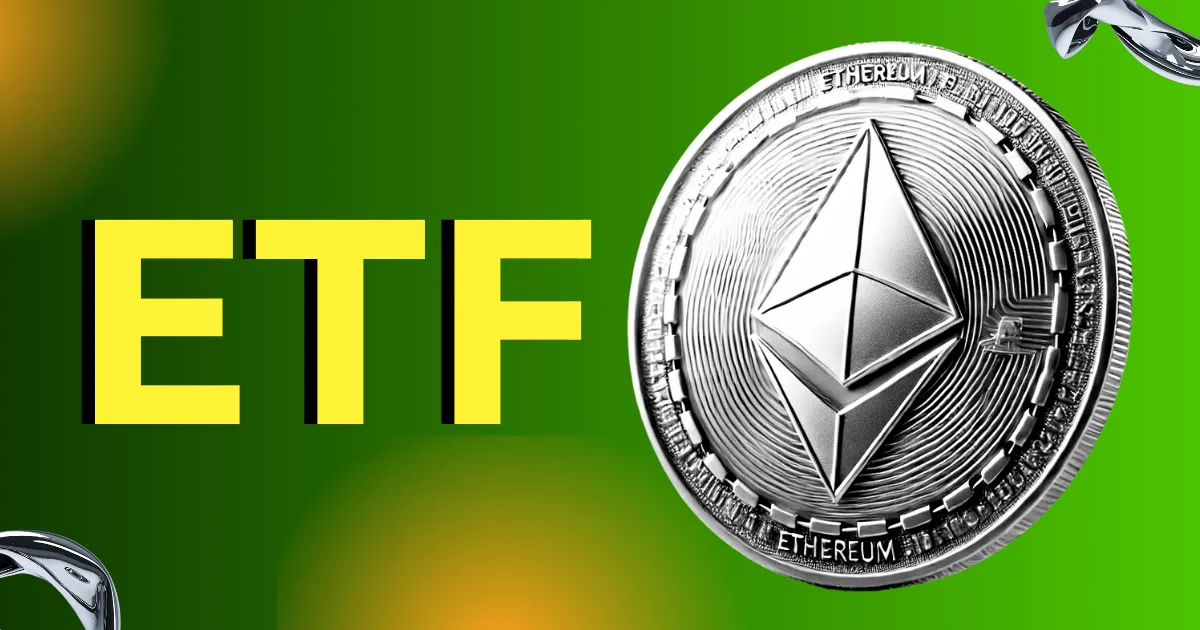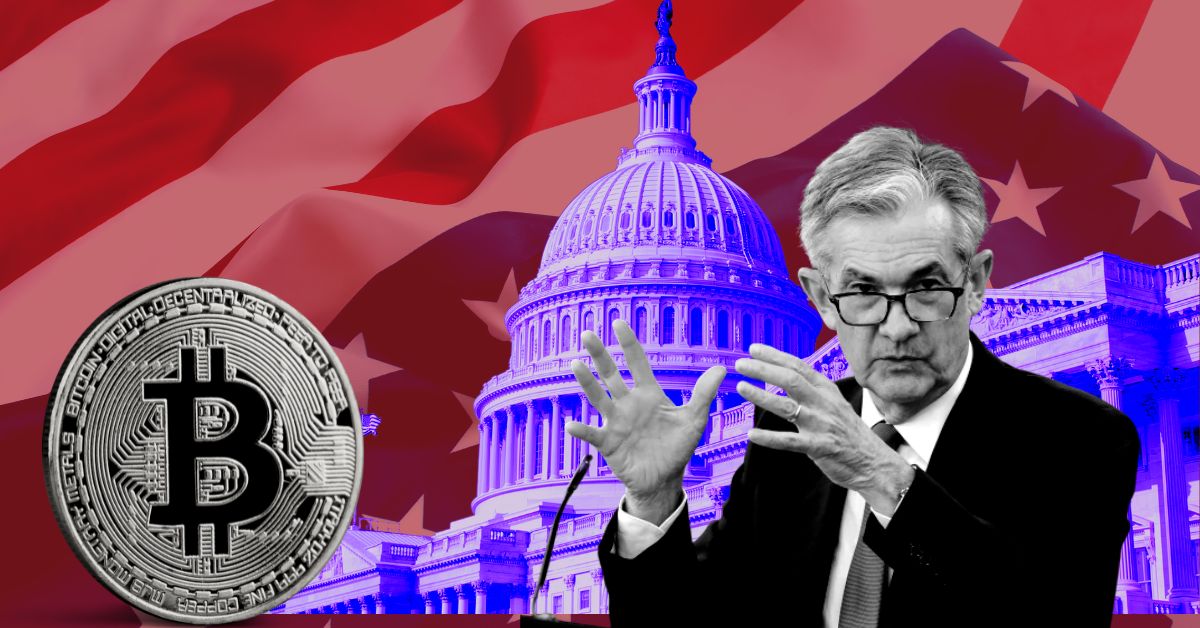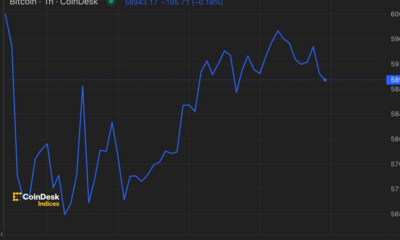Ethereum
Ethereum faces resistance at $4,000, but current data favors bulls

Ethereum has become a symbol of innovation in the blockchain space, attracting many innovators to develop their crypto projects there. As a result, there are many decentralized applications on the blockchain.
Ethereum is also the second largest blockchain and the largest altcoin project. This is the reason why the crypto market is expecting the US SEC to approve Ethereum spot ETFs in the near future. This analysis will cover the recent ETH price movement and its future catalysts.
ETH’s recent gains are linked to decreasing staking supply and demand, the popularity of DeFi, and the proof-of-stake burning mechanism
On February 25, Ethereum broke above the $3,000 price level, a critical resistance zone, and has been steadily rising since. On March 11, ETH reached $4,000, before pulling back slightly on the 12th. Current data suggests that ETH has the potential to surpass the $4,000 level and possibly enter a major bull run.
Confidence that ETH price will surpass the $4,000 level and enter an ETH bull run is based on several factors, including the decreasing supply of Ethereum, driven by demand for staking. ETH supply may decrease due to the network’s proof-of-stake burning mechanism. Once ETH rises above $4,000, it may encounter strong resistance at $4,065, $4,185, $4,220, and then $4,300.
Many ETH enthusiasts predict that an Ethereum season will take place in the near future. As a result, some Ethereum investors are holding on to ETH in anticipation of a higher price at the right time, considering that several expected upgrades on the blockchain could increase demand for the coin.
Source: x.com
As the screenshot indicates, crypto analyst and enthusiast Ryan S Adams expects the demand and price of ETH to increase due to the staking and restaking of the coin. The expansion of the DeFi ecosystem based on the Ethereum network will also likely increase demand for ETH, which could contribute to a potential Ethereum price surge. Once Ethereum price rises above $4,000, the market expects it to break above the $4,300 resistance level, positioning itself for Ether’s next bull run.
Ethereum Prices Become Catalysts as We Move Beyond Dencun Upgrade
Several factors are likely to influence the Ethereum Price in 2024, including an increase in staking, the Dencun upgrade, ETH ETFs and a decrease in its supply. The Bitcoin halving may also affect the price of ETH due to their correlation.
Decrease in supply of Ethereum: During a 30-day period that ended on February 24, the circulating supply of Ethereum decreased by 18,960 ETH, while starting on February 15, there was a preference for net withdrawals. The following chart gives a summary of net ETH transfers to exchanges, indicating an increase in selling pressure.

Net Ether Transfers to Exchanges – Glassnode
Usually, net transfers to exchanges increase when Ethereum holders want to sell their coins. Nevertheless, the fact that the price of Ether has remained stable around $2,300 indicates that the rise in Ethereum sales is not linked to a rise in prices.
SEC Approval of Spot ETH ETFs Could Trigger Ethereum Price Surge: We noted that the SEC’s spot approval of the Bitcoin ETF in January increased demand for Bitcoin. For example, BTC ETF issuers like BlackRock have acquired a lot of bitcoin in a short period of time. The market expects a similar effect on ETH demand if the SEC approves ETFs.
The approval of spot ETH ETFs will likely trigger a rise in Ethereum prices and a possible ETH bull run. Currently, many crypto analysts have said that there is a 50% chance that the SEC will approve ETFs. For example, Nikolaos Panigirtzoglou, an investment analyst at JPMorgan, told TheBlock that there is a 50% chance that the SEC will approve ETH ETFs. The earliest scheduled date for approval of Ethereum spot ETFs is May 23.
Future Ethereum premium increase: The market generally uses changes in the price of ETH futures to gauge the possible future trend of ETH. In a neutral ETH market, Ethereum futures often trade at a premium of between 5% and 10%. Significantly, a premium of more than 10% shows that demand for the coin may increase or remain high, influencing the rise in the price of the underlying asset. However, in the case of Ethereum, the premium remains above 14%, indicating strong demand for ETH.
The Ethereum Dencun Upgrade: A number of upgrades planned for the Ethereum blockchain, such as the recent one from Dencun, could also drive up the price of ETH. Dencun, the Ethereum protocol upgrade, launched on March 13, will bring significant benefits to the blockchain such as reduced transaction fees.
Increase in decentralized finance on Ethereum: Several crypto projects have launched decentralized financial protocols on the Ethereum blockchain, which could increase demand for ETH. For example, there has been an increase in liquid staking tokens (LRT) on the blockchain. Ether.FI and Puffer are examples of DeFi platforms that have introduced high-yielding liquid staking tokens (LRT). Interestingly, some of the recently introduced DeFi protocols are offering airdrops to the Ethereum community. As an example, Starknet, an Ethereum rollup, recently introduced the STRK airdrop, which helped increase demand for ETH. These factors, among others, can help boost the Ethereum season.
Conclusion
Ethereum’s all-time high was $4,706 – reached in November 2021. Currently, the $4,000 Ethereum price level provides some resistance, forcing the value of ETH to stay below for the time being . However, various factors can contribute to pushing up the price of ETH. The decrease in its circulating supply, the ETH refresh, the Dencun upgrade, and the increase in DeFi on the Ethereum blockchain could lead to an increase in the coin’s value – and a potential new all-time high in the months to come.
Ethereum
Crypto Token Ether (ETH) Rebounds Following Complaint About SEC Investigation Into Ethereum

The Ether token posted its best gain this week amid speculation that U.S. regulatory oversight of the blockchain ecosystem underlying the second-largest digital asset could ease.
The token climbed as much as 3.6% on Wednesday before paring some of its advance to trade at $3,562 as of 12:53 p.m. in Singapore. The rally was a modest tailwind for market leader Bitcoin and a string of smaller rivals.
Ethereum
Will they capture the same buzz in the market?

The launch of Ethereum spot exchange traded funds Exchange traded funds (ETFs) attracted significant market interest on July 23, with initial inflows surpassing $100 million. This is a notable change from the previous four days of outflows for U.S. spot Ether ETFs, which saw a total of $33.67 million in new investments.
This figure was, however, partly offset by an outflow of $120.28 million from Grayscale’s Ethereum Trust (ETHE). However, many crypto analysts believe that the Ethereum ETF will soon follow bitcoin’s path.
Ethereum ETF to Track Bitcoin
Katalin Tischhauser, head of investment research at Sygnum Bank and a former Goldman Sachs executive, predicted that Spot Ether exchange-traded funds could attract as much as $10 billion in assets under management in their first year.
She also predicted that Bitcoin ETFs could see inflows of $30 billion to $50 billion in their first 12 months, with Ethereum products likely following the same path.
Tischhauser noted that investing in Ethereum offers distinct advantages over Bitcoin. While Bitcoin is primarily viewed as a store of value, Ethereum’s value comes from revenue and cash flow. This makes Ether more relevant to traditional institutional investors compared to the perception of Bitcoin as “digital gold.”
Fee waivers to attract institutional investors
To attract institutional investors, several ETF issuers are waiving fees for their Ethereum spot funds. Franklin Templeton announced a 0.19% sponsorship fee, but will waive it for the first $10 billion in assets for six months. Meanwhile, Bitwise and VanEck will charge a 0.20% fee through 2025.
BlackRock revised its registration statement for its spot Ethereum ETF, ETHA, to include a 0.25% management fee. Grayscale launched its Grayscale Ethereum Mini Trust with the same 0.25% fee.
Ethereum ETFs Exclude Staking
The enthusiasm is, however, tempered by the lack of staking rewards of these ETFs. In May, BlackRock, Grayscale and Bitwise removed staking provisions from their SEC filings after discussions with the SEC.
As traditional investment institutions are limited by regulations and legal constraints, they can only invest through ETFs, without resorting to staking.
Also see: Crypto News Today: Bitcoin, Ethereum Brace for Volatility as Fed Holds Rates
Ethereum
SEC Hints It May Approve Ethereum ETFs at Last Minute, But ‘No Issuers Are Ready’

It sounded like an almost certain rejection from the Securities and Exchange Commissionbut just hours before the May 23 deadline to rule on VanEck’s application to launch an Ethereum spot exchange traded fundIt appears that the SEC may reconsider its decision.
CoinDesk First reported On Monday, the nine potential issuers that had filed to list and trade the ETFs were “abruptly” asked by regulators to update their 19b-4 filings on an expedited basis. A 19b-4 is what an exchange like the NYSE requires for new product introductions — in other words, the applicants and the exchange ask the SEC for permission to add the ETFs to their platforms.
Since rumors began circulating Monday afternoon, the price of Ether has climbed nearly 20%, trading near $3,750 as of 1:30 p.m. ET Tuesday.
It’s hard to believe that the SEC would do us a favor by approving the ETH spot ETF.
But politics is politics, and crypto has been winning the political battle for months.
Perhaps the Biden camp saw how many voters Trump could win over with a single pro-crypto comment and decided to change course.
— Jake Chervinsky (@jchervinsky) May 21, 2024
Since VanEck is the first exchange to file, its approval could hypothetically be a green light for others waiting to hear about their own 19b-4s. While rumors began circulating Monday that applications were being worked on, Bloomberg analysts updated their ratings from 25% to 75% approval.
But the news left issuers scratching their heads. Every issuer Bloomberg ETF analyst James Seyffart spoke to was “caught off guard by the SEC’s 180-degree turn,” he told Fortune. The agency reached out to filers for comment and updates just three days before the deadline, he said.
“This is not standard operating procedure, and everyone from issuers to exchanges to lawyers to market makers and more are scrambling to be ready for eventual approval and to meet SEC requirements,” Seyffart adds. The hasty nature of the pivot suggests it was likely a “political move,” the result of a “top-down decision” by the Biden administration, he speculates. “No issuer is ready,” he wrote on X.
It’s hard to believe that the SEC would do us a favor by approving the ETH spot ETF.
But politics is politics, and crypto has been winning the political battle for months.
Perhaps the Biden camp saw how many voters Trump could win over with a single pro-crypto comment and decided to change course.
— Jake Chervinsky (@jchervinsky) May 21, 2024
So far, Grayscale is the only potential issuer to post an update 19b-4 to the New York Stock Exchange website, for its application to transfer its Ethereum Mini Trust ETF. Meanwhile, Fidelity has abandoned its plan to put Ether in its ETF, according to a S-1 Update The filing was made with the SEC early Tuesday. In previous filings, the company had said it intended to “stake a portion of the trust assets” to “one or more” infrastructure providers, but now it “will not stake Ether” stored with the custodian.
Staking involves committing Ether to secure the network in exchange for a yield, which is currently around 3%, according to data from staking service Lido. Ark and Franklin Templeton have also considered staking in their applications. In today’s 19b-4 update from Grayscale, the company confirmed that it would not participate in staking. The fact that Grayscale highlighted this and Fidelity omitted it suggests that the SEC may have asked that staking be banned. Vance Spencer, co-founder of Business executivestold Fortune he believed the SEC’s last-minute requests included advice on staking.
Staking the underlying Ether in the ETF has been seen as a reason the SEC could reject the applications, with Chairman Gary Gensler expressing concern in March that digital assets using staking protocols could be considered securities under federal law. Staking could be “a significant complication,” Bitwise CIO Matt Hougan said. previously said Fortune.
However, even if the SEC approves VanEck’s 19b-4 on Thursday, it doesn’t guarantee clearance, as exchanges will need S-1 filings from issuers before the products can begin trading. When filing to launch a new security, an S-1 is the form that describes to potential investors and the SEC the structure of the asset, how it will be managed and, in this case, how it plans to mirror the performance of the underlying asset, namely Ether tokens.
But S-1 projects could take “weeks, if not months” to be approved, Seyffart said. written on X“That said, if we are correct and see these theoretical approvals later this week, that should mean that S-1 approvals are a matter of ‘when’ and not ‘if.’”
Recommended newsletter:
CEO Daily provides essential context for the information business leaders need to know. Every weekday morning, more than 125,000 readers trust CEO Daily for insights into leaders and their businesses. Subscribe now.
Fuente
Ethereum
FOMC Holds Interest Rates Steady, Bitcoin and Ethereum Prices Fall

After Federal Reserve Chairman Jerome Powell said a September rate cut “could be on the cards,” stocks soared to session highs. The tech-heavy Nasdaq 100 climbed 3.3% and the S&P 500 climbed 2%. However, the king cryptocurrency Bitcoin (BTC) fell 1.3% to $66,088, and Ethereum (ETH) fell about 1.11% to $3,313. Over the past 24 hours, the global cryptocurrency market cap also fell 0.71% to $2.39 trillion.
However, market analysts believe that this is a short-term decline, as Bitcoin and other cryptocurrencies, despite being in a bearish situation, are showing bullish signals. Although BTC is still struggling to break the $70,000 mark, it will be interesting to see how BTC will react in August before the rate cuts.
Federal Reserve Decision
On July 31, the U.S. Federal Reserve concluded a two-day meeting of the Federal Open Market Committee (FOMC) by choosing to keep benchmark interest rates unchanged at 5.25%-5.50%, in line with Wall Street expectations. The decision marked the eighth consecutive meeting without a rate change.
Towards a market rebound?
According to SantimentThe FOMC’s decision to maintain current interest rates led to an initial decline in cryptocurrency prices. Traders were hoping for a rate cut, which hasn’t happened since March 2020. A future rate cut could signal bullish trends for stocks and cryptocurrencies, potentially boosting markets for the remainder of 2024. Despite the initial sell-off, markets are likely to stabilize unless another major event impacts the cryptocurrency sector.
In the meantime, aggressive accumulation by bulls and increasing negative sentiment among the crowd could set the stage for a substantial market rebound.
Understanding the broader impact
Despite the anticipation surrounding the FOMC meeting, the impact on cryptocurrencies was limited as the pause on rates had already been factored into prices. Previous Fed decisions have shown minimal major impact on Bitcoin prices.
Historically, FOMC actions affect all asset classes. In 2020 and 2021, Bitcoin and other altcoins soared when the Fed cut rates to zero, only to reverse course in 2022 when rates began to rise. Investors moved trillions of dollars into lower-risk assets, with money market funds amassing over $6.1 trillion, earning an average return of 5%.
Furthermore, Bitcoin’s immediate resistance is noted at $66,852, with support at $65,000. The RSI is signaling oversold conditions, suggesting further declines are possible if the price falls below $65,900.
Investors are now closely watching the FOMC meeting for clues about inflation and economic growth, which could influence Bitcoin’s next move.
-

 News1 year ago
News1 year agoBitcoin (BTC) price recovery faces test on non-farm payrolls
-

 Bitcoin12 months ago
Bitcoin12 months ago1 Top Cryptocurrency That Could Surge Over 4,300%, According to This Wall Street Firm
-

 Altcoins12 months ago
Altcoins12 months agoOn-chain data confirms whales are preparing for altcoin surge with increased buy orders
-

 Bitcoin12 months ago
Bitcoin12 months agoThe US government may start accumulating Bitcoin, but how and why?
-

 News1 year ago
News1 year agoNew ByBit Listings for 2024: 10 Potential Listings
-

 News1 year ago
News1 year ago11 Best Crypto TikTok Accounts & Influencers in 2024
-

 Altcoins1 year ago
Altcoins1 year agoMarket giants have taken action!
-

 News1 year ago
News1 year ago11 Best Shitcoins to Buy in 2024: The Full List
-

 Ethereum1 year ago
Ethereum1 year agoTop Meme Coins by Market Capitalization in 2024
-

 News1 year ago
News1 year ago1.08 Trillion SHIBs Dumped on Major Crypto Exchange, What’s Going On?
-

 News1 year ago
News1 year ago19 Best Crypto Games to Play in 2024
-

 Altcoins1 year ago
Altcoins1 year agoAltcoin Recommended by Crypto Expert for Today’s Portfolio





